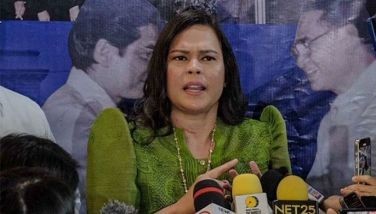Four presidents and the record of foreign direct investment attraction

It has been more than 20 years since the end of the Cory Aquino era when the country was restored to the pre-martial law political institutions. Four presidents have roosted over the nation, each with some varying degree of performance according to the promises they took with them when they entered office.
A key undertaking of any government is to raise the country’s economic performance. We live in a world of limited entrepreneurial talent in which local capital is relatively shy and also inadequate. There is also an urgent need for the nation to keep abreast of modern technology.
An easy alternative to raise the level and quality of investment is to attract more foreign direct investments. The immense success of our East Asian neighbors, including our ASEAN partners, in bringing in substantial inflows of FDIs had in no small way contributed to their rapid progress.
“Data on FDI.†The United Nations Conference on Trade and Development (UNCTAD) collects consistent data for a wide list of countries on FDI. We are interested mainly in the FDI flows to ASEAN member countries here.
The only tweaking to be done is to adjust the data to the peculiarities of our political institutions. The presidential term of six years ends on June 30. The new president begins it the next day. Data are collected on an annual basis. This requires that we split the yearly data between the two presidents.
The irregular transition date between Estrada and Macapagal Arroyo was January 2001 because of EDSA II. In that case, the year’s data was split proportionately at one-twelfth of the FDI flow for the year for Estrada, the deposed president, and Macapagal Arroyo received the remainder for the year.
“Fidel Ramos: president, 1992-1998 (June).†Fidel Ramos had an eventful presidency given that he entered with a massive economic problem to solve – the electric power crisis. He turned to the private sector and to foreign investment for immediate remedy. He further liberalized the economy in a faster way –opening up the telecommunications sector to competition and creating more private export processing zones. He worked to overcome many obstacles and restrictions in investment promotion through innovative incentives in contracting – providing high returns to investments. As a result, he was able to address the power crisis. Sometimes, he was thwarted by the Supreme Court (e.g., privatization of Manila Hotel).
Ramos brought in $9,482.7 billions of foreign direct investments, which meant that on a yearly basis, he succeeded in bringing in $1,580.6 billions of new FDI.
“Joseph Estrada: president 1998 (July) to 2001 (January).†Erap had a good start, armed with a popular mandate. But his skills as a small town mayor did not match the requirements of the presidency. Falling short on leadership as well as lifestyle, he was booted out of office by impeachment and a people power revolution. His concern for improving FDIs led him to set up a commission to recommend amendments on the restrictive provisions of the Constitution, but his term was cut and this initiative was likewise short.
Economic uncertainties and other problems arising from his rocky leadership led to FDIs shying away from the country. He attracted $3,429.3 billion, or a yearly inflow of $1,146.4 billion.
“Gloria Macapagal Arroyo: president 2001-2010 (June).†GMA filled up the four-year unfinished term of the deposed Estrada presidency and was elected to a six year term, affording her a longer time to make an impact on the nation. She began her presidency auspiciously, but squandered much of it on the basis of her mainly political approach to important economic issues. The “Hello, Garci†scandal and the fertilizer scam shot down her credibility as elected leader.
Despite this, however, her record in bringing in FDI appeared not to be different from that of other presidents. During her term, $16,012.4 billion of FDI flows came in. On a per year basis, this was $1,779.2 billion, just slightly higher than the comparative data during the Ramos presidency.
Note that FDIs are measured in current US dollars so that the two presidents brought in relatively the same amount of FDIs into the country on a yearly basis due to weakening of the US dollar and inflation.
“Benigno Aquino III: president, 2010 (July) to present.†The FDI flows during Noynoy’s term have been relatively higher. He has brought in so far $4,300.2 billion of FDI flows, the equivalent of $2,150.1 billion average per year. (Note: The dollar weakness also affects the amount of the FDI flows.)
FDI flows are likely to be higher going forward in the Noynoy Aquino presidency. With investment grade rating and continued sound macro fundamentals, the Philippine economic record is likely to be much better.
However, that potential will be capped unless he improves the FDI climate in the country through direct reforms dealing with FDI policies. He appears to be under an illusion that the move to change the restrictive provisions to foreign investments in the Constitution would not make a big difference. Unless his mindset changes on this point, Aquino’s future performance on this account will not be spectacularly much better.
“Philippine FDI performance is dismal, relative to neighbors.†The country compares poorly, in fact dismally, within the ASEAN region in the matter of FDI inflows. I will show this next week.
Each president has been living through the curse of the “original sin†of Philippine development policy. This has been a legacy of misguided nationalism. It has further been fuelled by self-interest by those who control the nation’s resources who have kept our presidents (whom they support) from doing their proper jobs on this score. That curse is embodied in the restrictive economic provisions of the constitution in the matter of investments in land, in the development and use of natural resources, and in the operation of public utilities.
All presidents have tried to overcome these provisions by introducing special ways and incentives by which foreigners could be encouraged. However, the whole country could not advance well when these critical sectors – especially public utilities – are in the way of improving the critical services required by a good business environment.
My email is: [email protected]. Visit this site for more information, feedback and commentary: http://econ.upd.edu.ph/gpsicat/
- Latest
- Trending


























